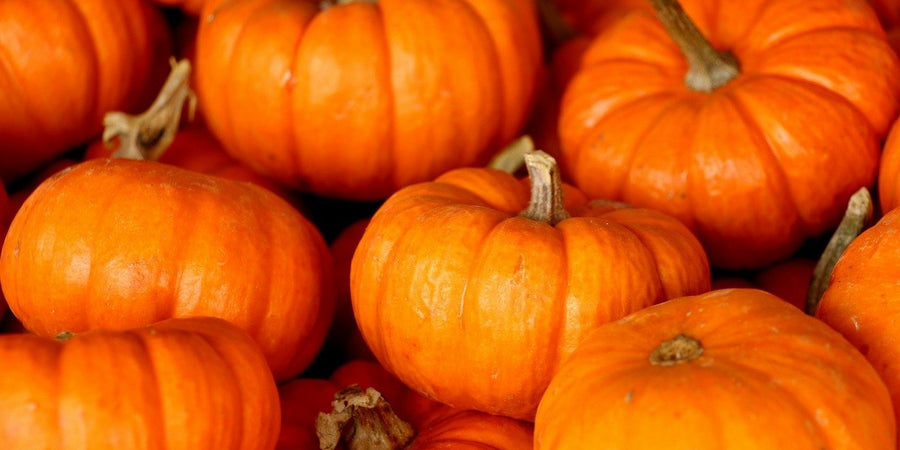How To Grow Squash

Winter Squashes and Pumpkins with their solid structures make them a wonderful vegetable to store over the winter months that does not require space in the freezer or cupboard to store, just a cool frost free area and they will keep right into the following spring.
Here's Our Guide to Growing Squash:
How, Where & When to Grow Squash
Squash require long hot summer to ripen the fruit fully. Therefore best to sow seeds mid-spring under cover for successful germination within 10-12 days when suitable conditions are met. Sow 2 seeds per 9cm pot, which will prevent root disturbance as they grow. On germination, cut off weaker of the 2 seedlings. Meantime prepare in readiness, the planting position, by incorporating well-rotted moisture retentive compost.
Here are a few pointers to help you with squash success:
- Mice love squash seeds! Make sure you protect them by covering them with mesh
- Use potting compost rather than seed compost as they are hungry
- When planting out try to protect them from wind, cover with horticultural fleece to keep them cosy
- Make sure you harden off plants before planting to minimise transplant shock
- If you are sowing direct, make sure the soil has warmed first, the seeds may rot in cold damp soil
An alternative way to grow squash is as part of what's known as the '3 sisters'. An introduction to the 3 sisters, these are climbing beans, pumpkins/squash and sweetcorn which when grown together form an interconnected plant guild. The beans add nitrogen to the soil for the pumpkins/ squash and anchor the sweetcorn, protecting it from winds. The sweetcorn acts as a living trellis for the beans to climb, the pumpkins or squash keep the other plants roots cool and moist acting as a living mulch. A very space efficient approach!
Distance
Once seedlings are hardened off, plant out 1 per planting position every metre between plants.
Regular Care
Water regularly until plants have established, watering around the plants, not over them. Slug pest love these too, set beer traps close to the plants. During hot spells, plants will benefit from a layer of mulch and with the onset of first flower start weekly high potash feed, to encourage growth both on the fruit and to produce further flowers. Set fruit on a bed of straw to prevent from rotting on the wet soil.
Harvesting Squash
Quick tips to look out for:
• Plants dying back - if the plants are dying back then most of the fruits are probably ready, and the ones that are not, will not reach maturity anyway
• Colour change - the colour of many squashes changes when they are ripe, similar to other fruits such as tomatoes. For instance Red Kuri goes from orange to a deep red.
• Corky stems - the stems go 'corky' when they are ripe.
• Hollow sound - ripe squashes usually sound hollow when tapped compared to unripe ones
Squash fruits are ready to harvest when the fruits have developed hard skin and by late summer but must be harvested before first frost arrives. Look also for the stalk of any fruit turning from green to brown, with a little ribbing which indicates some dryness. There will be shrinkage also, making the stalks very hard!
Best method of harvest therefore is not to try and cut the stalk, but to cut the trailing stem either side of it. This reduces a risk of snapping stalk from fruit, which would mean reduced time of storage.
After harvest of winter squash, keep them as warm as possible for a week or more. This finishes the ripening or curing process, and increases sweetness. Following that keep them as dry as possible, preferably in the house, and you can use them at any stage in the winter.

Storing
Here are some tips:
- Wait until the fruits have fully changed colour before harvesting, this is the plant's way of saying that the fruits are mature. They should sound hollow when tapped. It's ok to let the plants die back before harvest but they do need to be brought in before the first hard frost comes (they will fine in a light frost).
- Handle with extreme care while harvesting and transporting the fruits, any blemishes are a point of entry for moulds. Be particularly careful not to break off the stalks for this same reason - any damaged fruits can be put aside and eaten first.
- 'Cure' the fruits in a warm dry place for a couple of weeks (e.g. polytunnel or glasshouse), this toughens the skin, increasing the storability.
- Store cured fruits in a dry airy place, making sure they are not touching each other (points where they touch are likely to rot). So do not store in a pile, tempting and space-efficient as it may be!
- Check your squashes weekly for signs of rot and eat any that are beginning to turn.
Nutrition
Squash is a great source of fibre, as well as vitamins including A, C, E and B vitamins along with minerals such as calcium, magnesium, and zinc. Three tablespoons of cooked butternut squash counts as one of your five-a-day.
Culinary
Squash is one of winter’s most iconic vegetables and offers a whole host of tempting ways to cook with it…Add Butternut Squash to macaroni cheese…a vegetarian Moroccan chickpea, Squash and Cavolo Nero stew…carve out the Pumpkin and make a Pumpkin hummus served in the Pumpkin!
Rather surprisingly the seeds are actually the most nutrient-dense part of the squash which is why rodents and badgers often hollow them out and leave the flesh.
You can turn the seeds into a delicious snack by boiling them in salty water for 5-10 minutes and then toss them in oil, season, and bake in the oven at 180C for 10 minutes.
Growing Guides
If you're thinking of sowing other vegetable and herb seeds, discover more of our growing guides.




